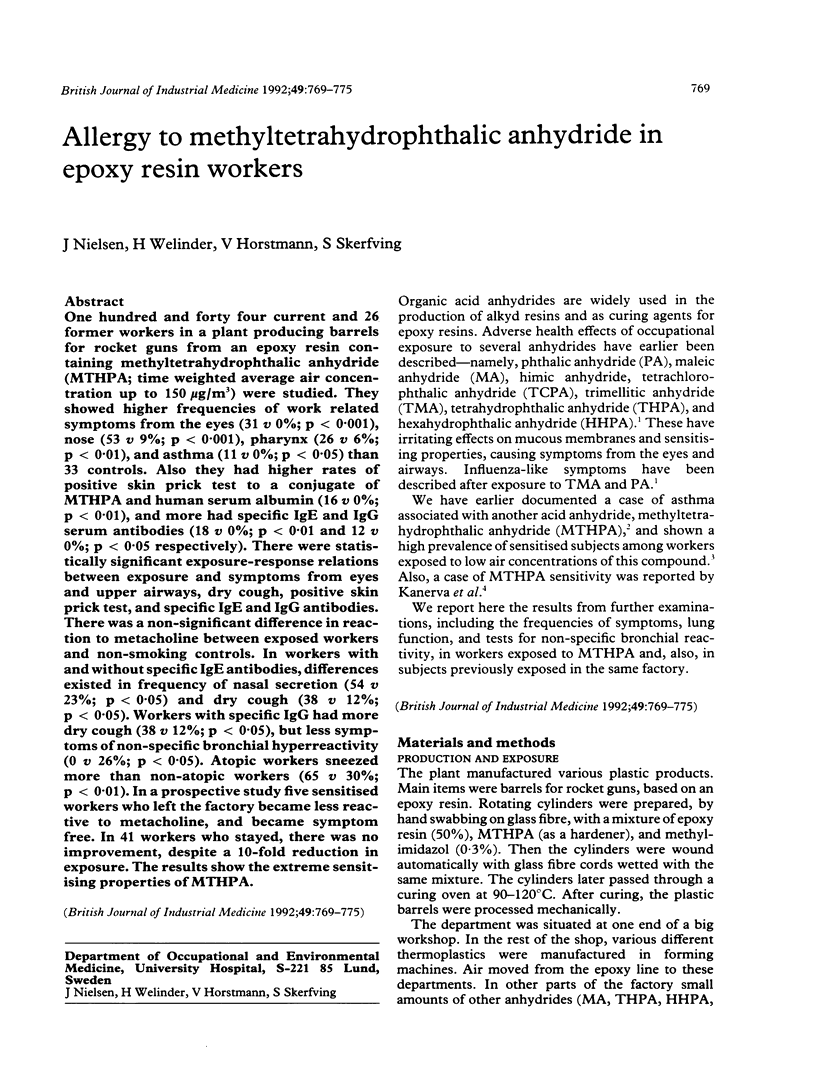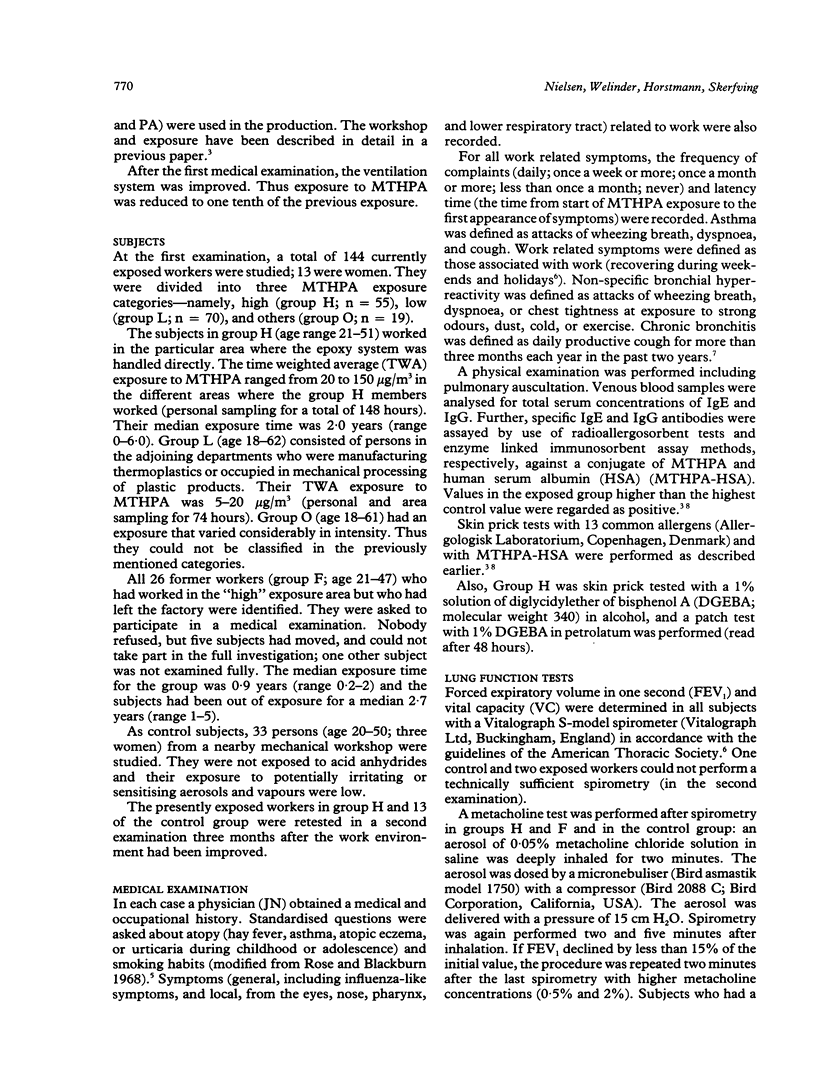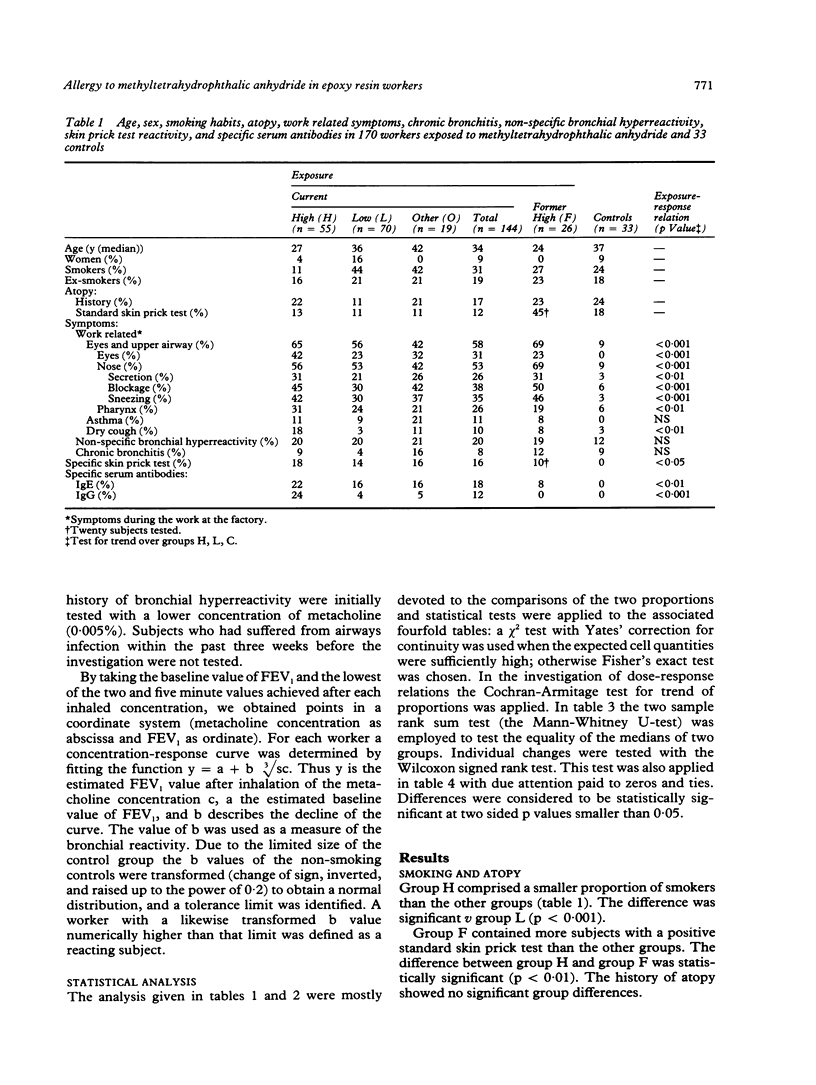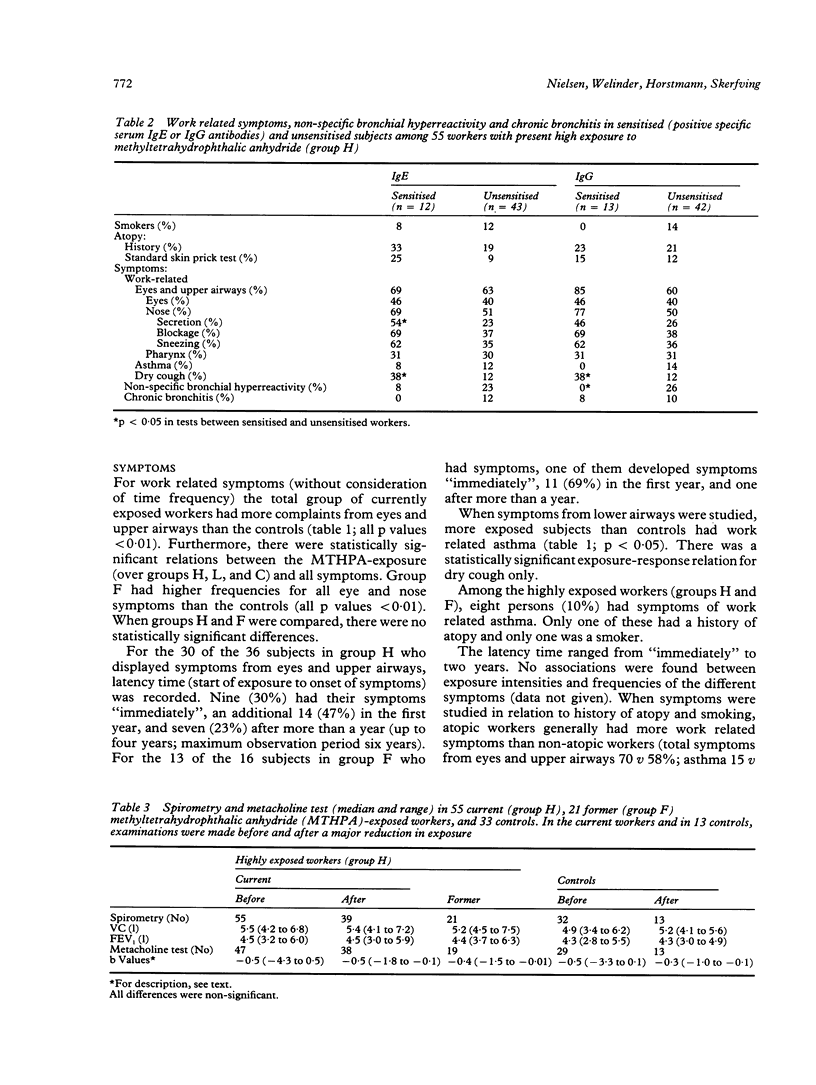Abstract
One hundred and forty four current and 26 former workers in a plant producing barrels for rocket guns from an epoxy resin containing methyltetrahydrophthalic anhydride (MTHPA; time weighted average air concentration up to 150 micrograms/m3) were studied. They showed higher frequencies of work related symptoms from the eyes (31 v 0%; p < 0.001), nose (53 v 9%; p < 0.001), pharynx (26 v 6%; p < 0.01), and asthma (11 v 0%; p < 0.05) than 33 controls. Also they had higher rates of positive skin prick test to a conjugate of MTHPA and human serum albumin (16 v 0%; p < 0.01), and more had specific IgE and IgG serum antibodies (18 v 0%; p < 0.01 and 12 v 0%; p < 0.05 respectively). There were statistically significant exposure-response relations between exposure and symptoms from eyes and upper airways, dry cough, positive skin prick test, and specific IgE and IgG antibodies. There was a non-significant difference in reaction to metacholine between exposed workers and non-smoking controls. In workers with and without specific IgE antibodies, differences existed in frequency of nasal secretion (54 v 23%; p < 0.05) and dry cough (38 v 12%; p < 0.05). Workers with specific IgG had more dry cough (38 v 12%; p < 0.05), but less symptoms of non-specific bronchial hyperreactivity (0 v 26%; p < 0.05). Atopic workers sneezed more than non-atopic workers (65 v 30%; p < 0.01). In a prospective study five sensitised workers who left the factory became less reactive to metacholine, and became symptom free. In 41 workers who stayed, there was no improvement, despite a 10-fold reduction in exposure. The results show the extreme sensitising properties of MTHPA.
Full text
PDF






Selected References
These references are in PubMed. This may not be the complete list of references from this article.
- Brubaker R. E., Muranko H. J., Smith D. B., Beck G. J., Scovel G. Evaluation and control of a respiratory exposure to 3-(dimethylamino) propylamine. J Occup Med. 1979 Oct;21(10):688–690. [PubMed] [Google Scholar]
- Corrao W. M., Braman S. S., Irwin R. S. Chronic cough as the sole presenting manifestation of bronchial asthma. N Engl J Med. 1979 Mar 22;300(12):633–637. doi: 10.1056/NEJM197903223001201. [DOI] [PubMed] [Google Scholar]
- Ferris B. G. Epidemiology Standardization Project (American Thoracic Society). Am Rev Respir Dis. 1978 Dec;118(6 Pt 2):1–120. [PubMed] [Google Scholar]
- Fuller R. W., Jackson D. M. Physiology and treatment of cough. Thorax. 1990 Jun;45(6):425–430. doi: 10.1136/thx.45.6.425. [DOI] [PMC free article] [PubMed] [Google Scholar]
- Hagmar L., Nielsen J., Skerfving S. Clinical features and epidemiology of occupational obstructive respiratory disease caused by small molecular weight organic chemicals. Monogr Allergy. 1987;21:42–58. [PubMed] [Google Scholar]
- Kanerva L., Jolanki R., Tupasela O., Halmepuro L., Keskinen H., Estlander T., Sysilampi M. L. Immediate and delayed allergy from epoxy resins based on diglycidyl ether of bisphenol A. Scand J Work Environ Health. 1991 Jun;17(3):208–215. doi: 10.5271/sjweh.1718. [DOI] [PubMed] [Google Scholar]
- Karlsson J. A., Hansson L., Wollmer P., Dahlbäck M. Regional sensitivity of the respiratory tract to stimuli causing cough and reflex bronchoconstriction. Respir Med. 1991 Jan;85 (Suppl A):47–50. doi: 10.1016/s0954-6111(06)80254-4. [DOI] [PubMed] [Google Scholar]
- Kongerud J., Søyseth V. Methacholine responsiveness, respiratory symptoms and pulmonary function in aluminum potroom workers. Eur Respir J. 1991 Feb;4(2):159–166. [PubMed] [Google Scholar]
- Moller D. R., Gallagher J. S., Bernstein D. I., Wilcox T. G., Burroughs H. E., Bernstein I. L. Detection of IgE-mediated respiratory sensitization in workers exposed to hexahydrophthalic anhydride. J Allergy Clin Immunol. 1985 Jun;75(6):663–672. doi: 10.1016/0091-6749(85)90091-0. [DOI] [PubMed] [Google Scholar]
- Nielsen J., Bensryd I., Almquist H., Dahlqvist M., Welinder H., Alexandersson R., Skerfving S. Serum IgE and lung function in workers exposed to phthalic anhydride. Int Arch Occup Environ Health. 1991;63(3):199–204. doi: 10.1007/BF00381569. [DOI] [PubMed] [Google Scholar]
- Nielsen J., Welinder H., Schütz A., Skerfving S. Specific serum antibodies against phthalic anhydride in occupationally exposed subjects. J Allergy Clin Immunol. 1988 Jul;82(1):126–133. doi: 10.1016/0091-6749(88)90062-0. [DOI] [PubMed] [Google Scholar]
- Nielsen J., Welinder H., Skerfving S. Allergic airway disease caused by methyl tetrahydrophthalic anhydride in epoxy resin. Scand J Work Environ Health. 1989 Apr;15(2):154–155. doi: 10.5271/sjweh.1869. [DOI] [PubMed] [Google Scholar]
- Short R. D., Johannsen F. R., Ulrich C. E. A 6-month multispecies inhalation study with maleic anhydride. Fundam Appl Toxicol. 1988 Apr;10(3):517–524. doi: 10.1016/0272-0590(88)90298-9. [DOI] [PubMed] [Google Scholar]
- Venables K. M. Low molecular weight chemicals, hypersensitivity, and direct toxicity: the acid anhydrides. Br J Ind Med. 1989 Apr;46(4):222–232. doi: 10.1136/oem.46.4.222. [DOI] [PMC free article] [PubMed] [Google Scholar]
- Venables K. M., Topping M. D., Howe W., Luczynska C. M., Hawkins R., Taylor A. J. Interaction of smoking and atopy in producing specific IgE antibody against a hapten protein conjugate. Br Med J (Clin Res Ed) 1985 Jan 19;290(6463):201–204. doi: 10.1136/bmj.290.6463.201. [DOI] [PMC free article] [PubMed] [Google Scholar]
- Venables K. M., Topping M. D., Nunn A. J., Howe W., Newman Taylor A. J. Immunologic and functional consequences of chemical (tetrachlorophthalic anhydride)-induced asthma after four years of avoidance of exposure. J Allergy Clin Immunol. 1987 Aug;80(2):212–218. doi: 10.1016/0091-6749(87)90131-x. [DOI] [PubMed] [Google Scholar]
- Vogelmeier C., Baur X., Fruhmann G. Isocyanate-induced asthma: results of inhalation tests with TDI, MDI and methacholine. Int Arch Occup Environ Health. 1991;63(1):9–13. doi: 10.1007/BF00406191. [DOI] [PubMed] [Google Scholar]
- Welinder H., Nielsen J., Gustavsson C., Bensryd I., Skerfving S. Specific antibodies to methyltetrahydrophthalic anhydride in exposed workers. Clin Exp Allergy. 1990 Nov;20(6):639–645. doi: 10.1111/j.1365-2222.1990.tb02702.x. [DOI] [PubMed] [Google Scholar]
- Welinder H., Nielsen J. Immunologic tests of specific antibodies to organic acid anhydrides. Allergy. 1991 Nov;46(8):601–609. doi: 10.1111/j.1398-9995.1991.tb00630.x. [DOI] [PubMed] [Google Scholar]
- Wernfors M., Nielsen J., Schütz A., Skerfving S. Phthalic anhydride-induced occupational asthma. Int Arch Allergy Appl Immunol. 1986;79(1):77–82. doi: 10.1159/000233946. [DOI] [PubMed] [Google Scholar]
- Zeiss C. R., Patterson R., Pruzansky J. J., Miller M. M., Rosenberg M., Levitz D. Trimellitic anhydride-induced airway syndromes: clinical and immunologic studies. J Allergy Clin Immunol. 1977 Aug;60(2):96–103. doi: 10.1016/0091-6749(77)90033-1. [DOI] [PubMed] [Google Scholar]


